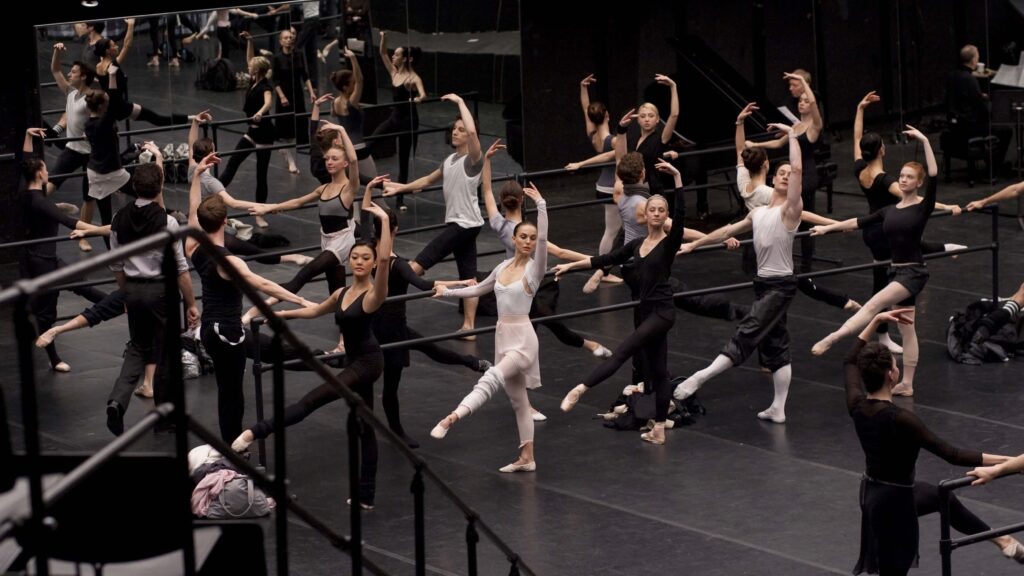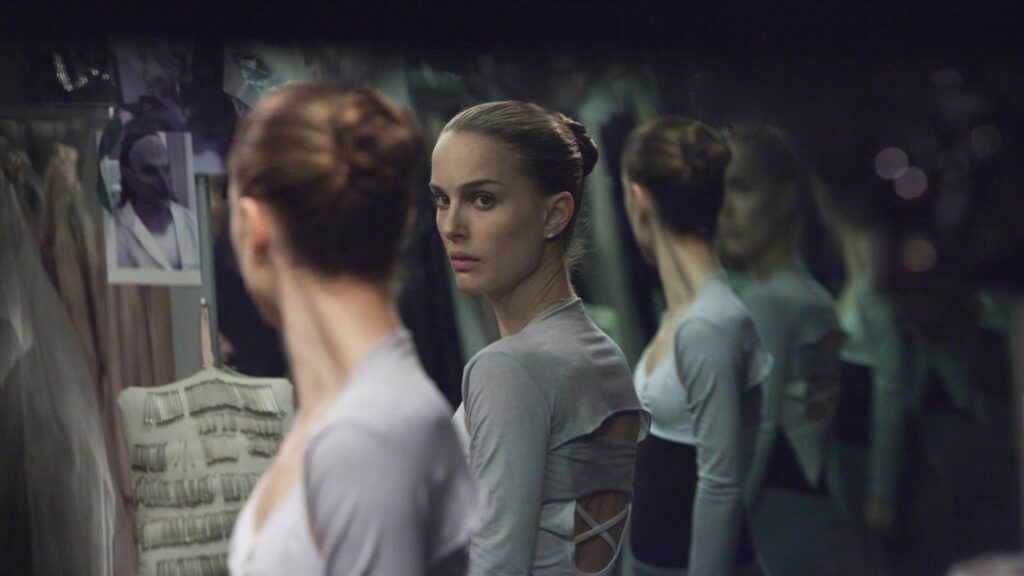Black Swan

2010, R, Thriller, 1h 48m
Table of Contents
What Is Black Swan About?
A ballerina obsesses over the lead role for “Swan Lake”, but her dark side emerges to compete for the spot against a rival friend.
Why You Should Watch Black Swan
Black Swan, directed by Darren Aronofsky, is a tour de force of psychological horror set against the demanding backdrop of professional ballet. The film navigates the mind of Nina Sayers, played brilliantly by Natalie Portman, a young and overly sheltered ballet dancer poised for stardom, yet plagued by self-doubt and a relentless drive for perfection. As she competes for the dual role of the White and Black Swans in Tchaikovsky’s “Swan Lake,” she is drawn into a downward spiral of self-destruction that questions the boundaries between art, identity, and sanity.
Aronofsky teams up once again with cinematographer Matthew Libatique to craft a film that is as visually arresting as it is emotionally charged. The use of a handheld camera produces an intimate, almost suffocating experience that pulls the viewer into Nina’s increasingly fractured reality. Every pirouette and plié is imbued with a sense of urgency, capturing the physical toll of ballet on the body and the emotional toll of perfection on the mind. The strategic use of mirrors serves as a constant reminder of Nina’s duality, a fractured self-image that becomes increasingly distorted as the film progresses.

Natalie Portman’s performance is nothing short of phenomenal, securing her an Academy Award for Best Actress. She embodies both the frailty and the fierceness needed for the role, executing complex ballet sequences and dramatic scenes with equal finesse. The supporting cast, including Mila Kunis as the free-spirited Lily and Vincent Cassel as the manipulative director, deliver compelling performances that add depth to the narrative.
One of the most striking aspects of the film is its sound design and score, adapted from Tchaikovsky’s original ballet by Clint Mansell. The music ebbs and flows in perfect harmony with Nina’s psychological states, serving as both a traditional ballet score and an unsettling horror soundtrack. This blending of genres in the music parallels the film’s overall hybrid nature, combining elements of drama, psychological thriller, and body horror to create a unique cinematic experience.

However, it’s worth noting that the film does tread on the lines of sensationalism, particularly with its somewhat graphic depictions of body horror and its intense focus on the protagonist’s breakdown, which could be seen as an extreme representation of the challenges faced by professional dancers. This may alienate some viewers, but for those who appreciate the genre-blending and are prepared for an intense psychological journey, Black Swan is a must-watch.
The Theme of Black Swan
One of the central themes is the pursuit of perfection. Nina Sayers, the film’s protagonist, is a ballet dancer whose life revolves around achieving the unattainable ideal of flawless performance. This quest is physically and emotionally taxing, and the film doesn’t shy away from showing the grotesque sacrifices made at the altar of artistry. Her journey highlights the dangerous implications of perfectionism, a concept that, while glorified in various aspects of culture, can lead to devastating consequences, including physical harm and psychological breakdown.
Duality is another critical theme, perfectly encapsulated by the dual roles of the White and Black Swans in Tchaikovsky’s “Swan Lake,” which the film revolves around. The White Swan represents purity, innocence, and technical precision—all qualities that Nina initially embodies. The Black Swan, however, is the embodiment of sensuality, spontaneity, and emotional depth. Nina’s struggle to embrace these contrasting aspects within herself serves as a broader metaphor for the internal conflicts many people face when reconciling different facets of their identity.

Mental health is intricately woven into the fabric of the story. Nina’s unraveling sanity is portrayed with haunting accuracy, blurring the lines between hallucination and reality for both the character and the audience. Her descent into madness can be seen as a byproduct of intense societal and self-imposed pressures to conform and excel. While the film doesn’t explicitly diagnose her with a specific mental health condition, it does shed light on the significant toll that stress, ambition, and the pursuit of perfection can take on one’s mental well-being.
The theme of control and manipulation pervades the film on several levels—parental, professional, and personal. Nina’s relationship with her mother, Erica, reveals a toxic dynamic where love and care are weaponized to maintain a grip over her life. Additionally, Thomas, the ballet company’s director, exerts his own form of control, pushing Nina to emotional and physical extremes to extract the performance he desires. These relationships raise questions about the ethical limits of authority figures who wield significant influence over individuals in their care.
Lastly, the film explores the role of women in a competitive and demanding environment. Nina and her fellow dancers exist in a world where youth and physical beauty are prized, adding yet another layer of pressure. Nina’s interactions with Lily, her alternate, underscore the complexities of female relationships within a competitive framework, touching on themes of jealousy, admiration, and rivalry.
The Cinematography of Black Swan
The cinematography of “Black Swan,” directed by Darren Aronofsky and shot by Matthew Libatique, serves as an integral part of the film’s psychological narrative, bringing viewers into the mind of its protagonist, Nina, a ballet dancer struggling with the pressures of her role in “Swan Lake.” The film employs a handheld camera for many scenes, creating a sense of immediacy and disorientation that mimics Nina’s emotional state. This intimate, almost documentary-style shooting allows the audience to feel uncomfortably close to the characters, blurring the line between reality and Nina’s hallucinations.

Colors in the film are highly symbolic; the palette shifts from whites and soft pastels, representing Nina’s innocence and the White Swan character she initially embodies, to darker, more saturated colors like deep reds and blacks as Nina’s personality transforms and she takes on the characteristics of the Black Swan. Mirrors are a recurring motif, used not only to show the physicality of ballet but also to symbolize Nina’s fractured identity and duality. Scenes in front of mirrors often employ disorienting camera angles, heightening the sense of psychological unrest.
Lighting also plays a critical role in conveying mood and emotion. High contrast and harsh shadows are used to intensify moments of psychological horror, while softer, diffused lighting is used in more intimate or vulnerable scenes. The film often uses naturalistic lighting, especially in the dance rehearsal spaces, creating a stark contrast with the more stylized, theatrical lighting of the actual performances, adding another layer to the film’s play on reality and illusion.
The Soundtrack of Black Swan
The soundtrack for “Black Swan” was composed by Clint Mansell, who has worked with director Darren Aronofsky on several films, and also features music from the original score of “Swan Lake” by Pyotr Ilyich Tchaikovsky. The soundtrack perfectly captures the film’s dark and haunting atmosphere, and enhances the story’s psychological tension and emotional intensity.
Some of the most memorable tracks on the soundtrack include:
- “Nina’s Dream” – an ethereal and haunting piece that introduces the film’s main character and sets the tone for the story.
- “A New Swan Queen” – a dark and ominous track that reflects the growing tension and sense of danger as Nina becomes more obsessed with her role in the ballet.
- “Perfection” – a driving and intense track that underscores Nina’s relentless pursuit of perfection and the physical and emotional toll it takes on her.
- “Swan Lake, Op. 20: Act II, No. 10” – the iconic theme from Tchaikovsky’s “Swan Lake” ballet that plays a central role in the film’s plot.
You can listen to the motion picture soundtrack below.
- “Night of Terror” – a dark and intense track that plays during one of the film’s most disturbing and surreal scenes.
The Cast of Black Swan
- Natalie Portman as Nina Sayers – Nina is a ballerina who has been chosen to play the lead role of the White Swan in a production of “Swan Lake”. She is extremely dedicated to her craft but struggles with anxiety and self-doubt.
- Mila Kunis as Lily – Lily is a new dancer in the ballet company who becomes Nina’s friend and rival. She is more free-spirited and rebellious than Nina, and pushes her to explore her darker side.
- Vincent Cassel as Thomas Leroy – Thomas is the artistic director of the ballet company and the choreographer of “Swan Lake”. He is demanding and exacting, and pushes Nina to embrace her sensuality and embrace the duality of the Swan Queen character.
- Barbara Hershey as Erica Sayers – Erica is Nina’s overbearing and controlling mother who is also a former ballerina. She is fiercely protective of Nina and puts a great deal of pressure on her to succeed.
- Winona Ryder as Beth Macintyre – Beth is a former star of the ballet company who is forced into retirement. She becomes bitter and resentful of the younger dancers who are taking her place, and has a breakdown when she is not chosen to play the lead role in “Swan Lake”.
- Benjamin Millepied as David – David is a new choreographer in the ballet company and becomes involved in a romantic relationship with Nina’s insecurities.

The Filmmakers of Black Swan
- Darren Aronofsky – Director: Aronofsky is an American film director, producer, and screenwriter who directed and co-wrote the screenplay for “Black Swan”. He is known for his distinctive visual style and his focus on character-driven stories.
- Mark Heyman – Screenwriter: Heyman is an American screenwriter who co-wrote the screenplay for “Black Swan” with Aronofsky and Andres Heinz. Heyman originally came up with the idea for the film while he was a graduate student at Harvard University.
- Andres Heinz – Screenwriter: Heinz is an American writer and filmmaker who co-wrote the screenplay for “Black Swan” with Aronofsky and Heyman. Heinz was inspired by the world of ballet and the story of “Swan Lake” to come up with the initial idea for the film.
- Scott Franklin – Producer: Franklin is an American film producer who co-founded the production company Protozoa Pictures with Aronofsky. He produced Black Swan along with Aronofsky and Mike Medavoy.
- Mike Medavoy – Producer: Medavoy is an American film producer who has produced a number of acclaimed films throughout his career. He co-produced Black Swan along with Aronofsky, Franklin, and Brian Oliver.

Half Moon Cookies

Inspiration
Black Swan vs. White Swan

More About Black Swan
The mental illness portrayed in Black Swan is a form of psychosis, specifically a subtype of schizophrenia known as paranoid schizophrenia. This is a serious mental illness that can cause a person to experience delusions and hallucinations, as well as difficulty with thinking, emotions, and behaviors. In the film, the main character Nina experiences hallucinations and paranoid delusions, which become increasingly intense and overwhelming as the story progresses.
The film’s portrayal of schizophrenia is somewhat stylized and dramatized for the purposes of the story, but it does contain some accurate depictions of the illness. For example, Nina’s hallucinations often involve sensory distortions and a blurring of reality and fantasy, which is a common symptom of schizophrenia. The film also accurately portrays the impact that the illness can have on a person’s relationships, as Nina’s behavior becomes increasingly erratic and she becomes increasingly isolated from those around her.
It’s worth noting that Black Swan is a work of fiction and is not intended to be a definitive portrayal of schizophrenia. However, the film does explore some of the complexities and challenges of living with a serious mental illness, and the impact that this can have on a person’s life and relationships.
The black swan is often used as a symbol in literature, art, and popular culture, and its meaning can vary depending on the context in which it is used. In the film Black Swan, the black swan is a symbolic representation of the darker, more dangerous side of the main character, Nina, and the transformation that she undergoes over the course of the story.
The black swan is traditionally associated with mystery, elegance, and power, and is often used to represent the unknown or unexpected. In the context of the film, the black swan represents the dark and repressed aspects of Nina’s personality that she struggles to bring to the surface. In the ballet “Swan Lake,” which serves as the backdrop for the film’s story, the black swan represents a seductive and dangerous force that threatens the purity and innocence of the white swan.
As Nina strives to embody both the white swan and the black swan in her performance, the black swan becomes a powerful symbol of her inner turmoil and psychological struggles. The black swan is a manifestation of Nina’s fears, desires, and obsessions, and it ultimately leads her down a path of self-destruction and madness.
In a broader sense, the black swan can also be seen as a symbol of the unpredictable and the unknown, and a reminder that there are always hidden depths and complexities to the world around us. The black swan represents the idea that there is always more to discover and explore, and that sometimes the greatest truths and revelations come from unexpected places.
Black Swan received critical acclaim and was recognized with numerous awards and nominations. Here are some of the major awards that the film won:
- Academy Awards: The film won one of its five nominations, for Best Actress (Natalie Portman).
- Golden Globe Awards: The film won one of its four nominations, for Best Actress in a Drama (Natalie Portman).
- Screen Actors Guild Awards: The film won one of its three nominations, for Outstanding Performance by a Female Actor in a Leading Role (Natalie Portman).
- BAFTA Awards: The film won one of its twelve nominations, for Best Actress in a Leading Role (Natalie Portman).
- Critics’ Choice Awards: The film won four of its twelve nominations, for Best Actress (Natalie Portman), Best Supporting Actress (Mila Kunis), Best Cinematography, and Best Editing.
In addition to these major awards, Black Swan was also recognized by various critics’ associations and film festivals around the world, and was nominated for many other awards.

